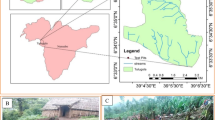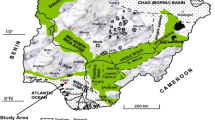Abstract
The goal of this study is to determine the geometrical and geotechnical characteristics of landslides under various geological conditions using detailed field surveys, laboratory soil tests and precipitation records. Three study areas are selected to consider different rocks, including gneiss in Jangheung, granite in Sangju and sedimentary rocks in Pohang, South Korea. Many landslides have occurred in these three areas during the rainy season. Precipitation records indicate that landslides occurring in the gneiss area of Jangheung and granite area of Sangju may be influenced by the hourly rainfall intensity rather than cumulative rainfall. However, landslides occurring in the sedimentary rock area of Pohang may be influenced by hourly rainfall intensity and cumulative rainfall. To investigate the factors that influence these types of landslides, a detailed landslide survey was performed and a series of laboratory soil tests were conducted. According to the detailed field survey, most landslides occurred on the flanks of mountain slopes, and the slope inclination where they occurred mostly ranged from 26 to 30 degrees, regardless of the geological conditions. The landslide in the gneiss area of Jangheung is larger than the landslides in the granite area of Sangju and sedimentary rock area of Pohang. Particularly, the landslide in the sedimentary rock area is shorter and shallower than the landslides in the gneiss and granite areas. Thus, the shape and size of the landslide are clearly related to the geological conditions. According to the integrated soil property and landslide occurrence analyses results, the average dry unit weight of the soils from the landslide sites is smaller than that of the soils obtained from the nonlandslide site. The average coefficient of permeability of soils obtained from the landslide sites is greater than that of soils obtained from the non-landslide sites with the same geology. These results indicate that the soils from the landslide sites are more poorly graded or looser than the soils from the non-landslide sites.
Similar content being viewed by others
References
Ahrendt A, Zuquette LV (2003) Triggering factors of landslides in Compos do Jordao city, Brazil. Bulletin of Engineering Geology and Environment 62: 231–244. DOI: 10.1007/ s10064-003-0191-8.
Caine N (1980) The rainfall intensity-duration control of shallow landslides and debris flows. Geografiska Annaler 62A (1-2): 23–27. DOI: 10.2307/520449.
Chau KT, Aze YL, Fung MK, et al. (2004) Landslides hazard analysis for Hong Kong using landslide inventory and GIS. Computers and Geosciences 30: 429–443. DOI: 10.1016/j.cageo.2003.08.013.
Cho YC, Song YS (2014) Deformation measurements and a stability analysis of the slope at a coal mine waste dump. Ecological Engineering 68: 189–199. DOI: 10.1016/j.ecoleng.2014.03.005
Dykes AP (2002) Weathered-limited rainfall triggered shallow mass movement in undisturbed tropic rainforest. Geomorphology 46: 73–93. DOI: 10.1016/S0169-555X (02)00055-7.
Fell R (1994) Stabilization of soil and rock slopes. Proc. North-East Asia Symposium and Field Workshop on Landslides and Debris Flows, Seoul, Korea, June 28-July 16. pp 7–73.
Fell R, Corominas J, Bonnard C, et al. (2008) Guidelines for landslides susceptibility, hazard and risk zoning for land-use planning. Engineering Geology. 102: 99–111. DOI: 10.1016/j.enggeo.2008.03.014.
Giannecchini R, Pochini A (2003) Geotechnical influence on soil slips in the Apian Alps (Tuscany): First results in the Cardoso area. Proc. International Conference on Fast Slope Movements-Prediction and Prevention for Risk Mitigation, Napoli, Italy, March 11-13. pp 241–245.
Hong WP (1999) Slope stabilization to control landslides in Korea, Geotechnical engineering case histories in Korea. Special publication to commemorate the 11th Asian Regional Conference on Soil Mechanics and Geotechnical Engineering, Seoul, Korea, August 16-20. pp 141–152.
Hurchinson JN (1988) Morphological parameters of landslides in relation to geology and hydrologeoloy. In: Bonnard C (ed.), Proc. 5th International Symposium on Landslides, Lausanne, Switzerland, July 10-15. Vol 1. pp 3–35.
Hwang SG, Guevarra IF, Yu BO (2009) Slope failure prediction using a decision tree: A case of engineered slopes in South Korea. Engineering Geology 104: 126–134. DOI: 10.1016/j.enggeo.2008.09.004.
Iverson RM (2000) Landslides triggering by rain infiltration. Water Resources Research 36 (7): 1897–1910. DOI: 10.1029/2000 WR900090.
Kim DH, Lee BJ (1986) Explanatory text of the geological map of the Chungsan sheet, Scale 1:50, 000. Korea Institute of Energy and Resources, Korea.
Kim SK, Hong WP, Kim YM (1991) Prediction of rainfall triggered landslides in Korea. In: Bell DH (ed.), Proc. 6th International Symposium on Landslides, Christchurch, Newzealand, February 10-14. Vol 2. pp 989–999.
Lee BJ, Kim YB, Lee SR, et al. (1999) Explanatory text of the geological map of the Seoul–Namcheonjeom sheet, Scale 1:250, 000. Korea Institute of Geology, Mining and Materials, Korea.
Lumb P (1975) Slope failures in Hong Kong. Quarterly Journal of Engineering Geology 8: 31–65. DOI: 10.1144/GSL.QJEG.1975.008.01.02.
Matsushi Y, Hattanji T, Matsukura Y (2006) Mechanisms of shallow landslides on soil-mantled hillslopes with permeable and impermeable bedrocks in the Boso peninsula, Japan. Geomorphology 76: 92–108. DOI: 10.1016/j.geomorph.2005.10.003.
Onda Y, Tsujimura M, Tabuchi H (2004) The role of subsurface water flow paths on hillslope hydrological processes, landslides and landform development in steep mountains of Japan. Hydrological Processes 18: 637–650. DOI: 10.1002/hyp.1362.
Schuster RL (1992) Recent advances in slope stabilization. In: Bell DH (ed.), Proc. 6th International Symposium on Landslides, Christchurch, Newzealand, February 10-14. Vol 3. pp 1715–1745.
Song YS, Hong WP, Woo KS (2012) Behavior and analysis of stabilizing piles installed in a cut slope during heavy rainfall. Engineering Geology 129-130: 56–67. DOI: 10.1016/j.enggeo.2012.01.012.
Um SH, Lee DW, Park BS (1964) Explanatory text of the geological map of the Sangju sheet, Scale 1:50, 000. Geological Survey of Korea, Korea.
Van Asch TWJ, Hendriks MR, Hessel R, Rapparge FE (1996) Hydrological triggering conditions of landslides in varved clays in the French Alps. Engineering Geology 42: 239–251. DOI: 10.1016/0013-7952(95)00082-8.
Wakatsuki T, Tanaka Y, Matsukura Y (2005) Soil slips on weathering limited slopes underlain by coarse-grained granite or fine-grained gneiss near Seoul, Republic of Korea. Catena 60: 181–203. DOI: 10.1016/j.catena.2004.11.003.
Wolle CM, Hachich W (1989) Rain-induced landslides in southern Brazil. proc. 12th International Conference on Soil Mechanics and Foundation Engineering, Rio de Janeiro, Brazil, August 13-18. pp 1639–1642.
Yalcin A (2007) The effects of clay on landslides: A case study. Applied Clay Science 38: 77–85. DOI: 10.1016/j.clay.2007.01.007
Author information
Authors and Affiliations
Corresponding author
Additional information
http://orcid.org/0000-0002-1860-676X
http://orcid.org/0000-0002-8521-9698
Rights and permissions
About this article
Cite this article
Kim, KS., Song, YS. Geometrical and geotechnical characteristics of landslides in Korea under various geological conditions. J. Mt. Sci. 12, 1267–1280 (2015). https://doi.org/10.1007/s11629-014-3108-z
Received:
Accepted:
Published:
Issue Date:
DOI: https://doi.org/10.1007/s11629-014-3108-z




